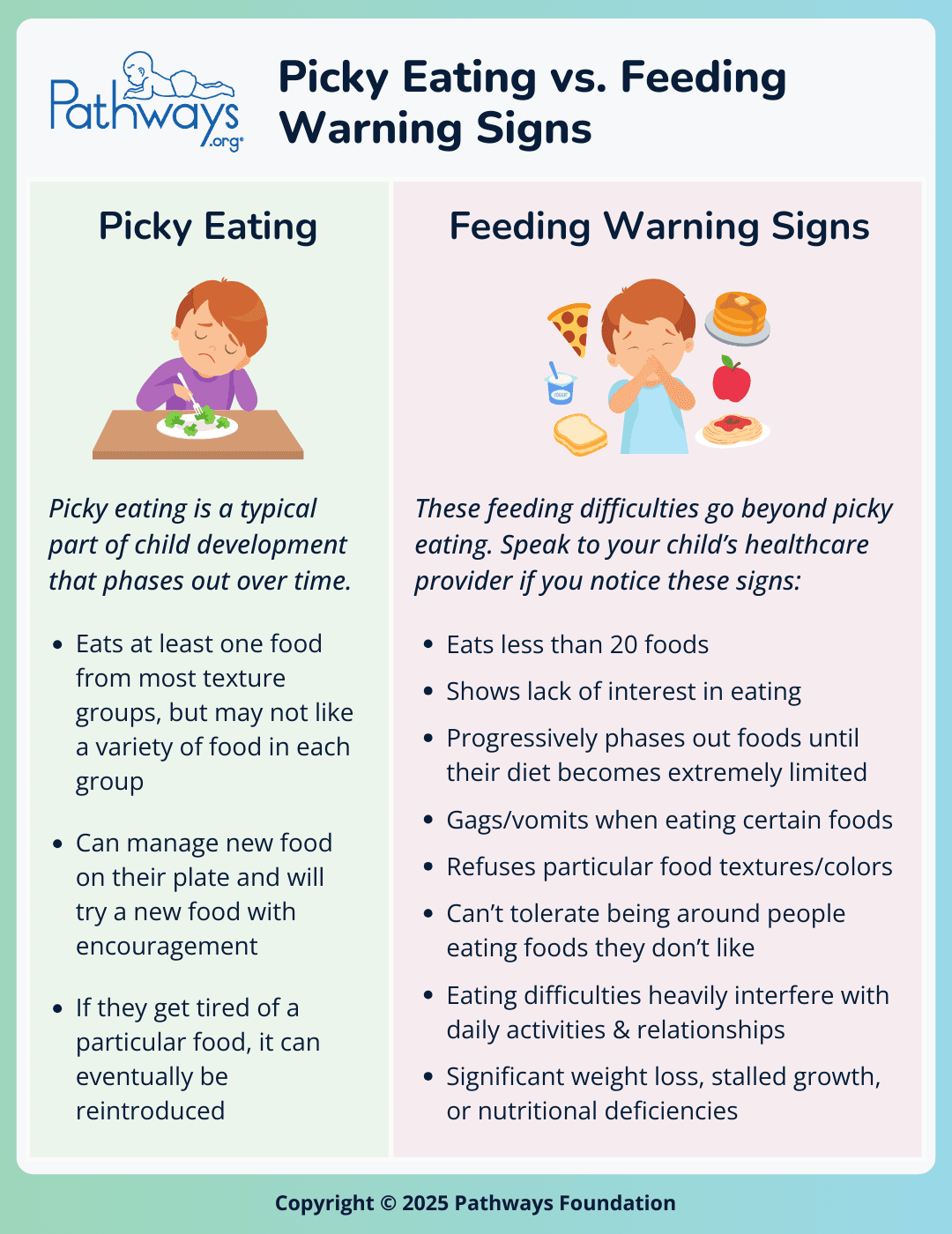Is It Picky Eating or Something More?

Picky eating is a typical part of children's development, but more extreme feeding difficulties can signal your child is dealing with something beyond that.
Some feeding warning signs to look out for include: an increasingly limited diet, difficulty being near others eating foods they don't like, and significant weight loss or nutritional deficiencies.
While there are many at-home strategies to help reduce picky eating, it's important to discuss feeding concerns with your child's healthcare provider for more personalized guidance.
Picky eating is practically a rite of passage for toddlers (aka it's a typical and expected part of child development!), but if you notice your child experiencing extreme feeding difficulties at every snack and mealtime, something more could be at play. Learn about feeding red flags, picky eating tips, and when to speak to a healthcare provider.
What is a picky eater?
These are common characteristics of picky eating:
Eats at least one food from most texture groups, e.g. crunchy, chewy, mushy, but may not like a variety of food in each group
Can manage new food on their plate and will try a new food with encouragement
If they get tired of a particular food, it can eventually be reintroduced
Note from a speech-language pathologist: It takes about 10 exposures to a new food for a typically developing child to accept it into their diet, so don’t worry if your child takes more than a few tries to warm up to a new food! This is typical and not a sign of feeding difficulties.
Signs Your Child May Be Dealing with More than Picky Eating
Here are some feeding warning signs to look out for:
Eats less than 20 foods
Shows lack of interest in eating
Gags or vomits when eating certain foods
Refuses particular food textures or colors
Can’t tolerate being around people eating foods they don’t like
Progressively phases out foods until their diet becomes extremely limited
Eating difficulties heavily interfere with daily activities and relationships
Experiences significant weight loss, stalled growth, or nutritional deficiencies

What can I do about picky eating?
Picky eating isn't necessarily something to be worried about. It's typical for your little one to go through slight appetite changes and be wary of new foods (or even ones they used to like!) as they go through toddlerhood. Plus, it's a sign your little one is gaining more independence and forming their own opinions!
For many kids, picky eating starts to phase out around school age. However, there are lots of things you can do now to encourage food exploration and build healthy eating habits, such as:
Limit super sugary or salty snacks and try serving meals at a consistent time each day. Picky eating can occur if a child fills up on snacks and is not hungry by mealtime.
Serve new foods alongside familiar foods your child already likes. For example, if your child likes ground beef and pasta, try serving it with veggie pasta sauce. This trick is what nutritionists call a "food bridge" (Learn how it can help with picky eating!).
Let them explore their food through touch, smell, or trying it in small bites. Messy food play is a great way to get your child more comfortable with different food smells and textures!
Serve mixed foods early and often. Consistently introducing mixed foods (e.g., yogurt with berries) will help your toddler get used to foods touching.
Invite them to help prepare meals or take them to the grocery store. Having causal conversations about food outside of the dinner table can help your child feel more relaxed and open to trying new foods.
Do not bribe or force your child to try a new food. Simply continue presenting it as an option alongside familiar foods and keep the pressure off. Sometimes, just seeing you eat it may be enough to convince them to try it on their own terms!

Learn more about picky eating and discover pro tips from speech-language pathologists!
What can I do if I'm concerned about my child's eating habits?
Trust your instincts! If you suspect that your child has feeding difficulties beyond picky eating, keep a food journal to track their eating behaviors, and bring your observations to the next visit with your child’s healthcare provider. You may be referred to a specialist who can develop strategies to help your child reframe their thoughts surrounding food, expand their diet, and improve their overall nutrition.
It can help to make a list of your child's "safe" foods (ones they always eat and enjoy), those they will tolerate sometimes, and foods they will not touch. This may make it easier for the specialist to create a plan that's personalized and approachable to your child.





